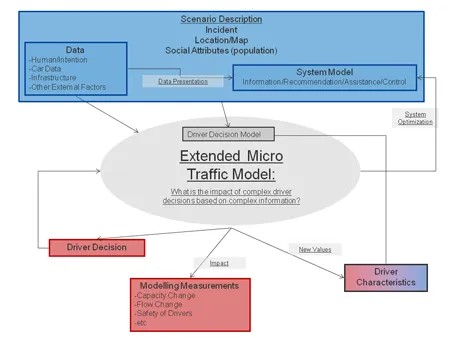SOCIONICAL
Extending Traffic Models to include Ambient Intelligence
Project Description
The project “SOCIONICAL” will advance Complexity Science modelling methods through the exploration of two project scenarios. Both scenarios capture relationships between humans and devices with ‘Ambient Intelligence’ (AmI). The two scenarios are:
- Emergency Evacuation
- Future Traffic Systems
The project brings together 14 partners from across the EU. These include groups with,
- expertise in various complexity science based modelling methods
- experience in real evacuations and evacuation simulation
- experience in driving simulation and driving device interaction
- expertise in translating complex scientific results into practical public policy recommendations
Tasks of the Chair
The chair will work on extending existing analytical traffic models to include AmI interactions. The central tasks are to describe in detail a sub-scenario of a broader ‘AmI in traffic’ description, create a suitable data set and model the scenario effectively. Work will be carried out closely with other partners in order to feed realistic decision data into the model, and our results will then be communicated to other modelling partners.
Work at the chair will consider future traffic optimization systems, where both inside and outside the vehicle, the goal will be to minimize congestion, recover from unexpected events, and facilitate cooperative behaviour. Already, some cars are equipped with a combination of both automatic/adaptive cruise control (ACC) systems and navigational aids with congestion updates via the Radio Data System (RDS-TMC). In addition, it is predicted that systems of the future will advise drivers of the intentions of other drivers and queues of drivers at junction points, in order to enhance considerate behaviour. Based on this information, a system may make a recommendation, but the driver must decide what to do.

This modelling will allow the chair to answer questions including the following:
- How does traffic flow (capacity) change with enhanced communication (information only, recommendations, individual decisions), for different penetration rates?
- How does traffic flow change with (AmI facilitated) cooperation, especially when including different resulting behaviours (cooperative, aggressive, selfish etc…)
- Does traffic flow change under central control that knows everything and controls vehicle movements in a way that is optimal for the system vs. a distributed system?
- What are the global effects (e.g. congestion waves) resulting from different kinds of local interactions?
| Keywords | Car to Car Communication, Cooperative Systems, Traffic Management, Complexity Science |
| Funding | EU 7th Framework Programme - more info |
| Partners | University of Passau, Germany (Embedded Systems Lab, Computer Networks Lab, East Asian Studies) Beacon Tech, Israel University of Linz, Austria London School of Economics, UK ETH Zurich, Switzerland VU University of Amsterdam, Netherlands AGH University of Science and Technology Krakow, Poland University of Würzburg, Germany Fraunhofer Institute for Applied Information Technology, Germany SICE S.A., Spain Rome Fire Fighters, Italy Smart Care, Italy University of Halle-Wittenberg, Germany |
| Duration | February 2009 till February 2013 |
| Contact | Matthew Fullerton, Nihan Celikkaya |
| Homepage | www.socionical.eu |